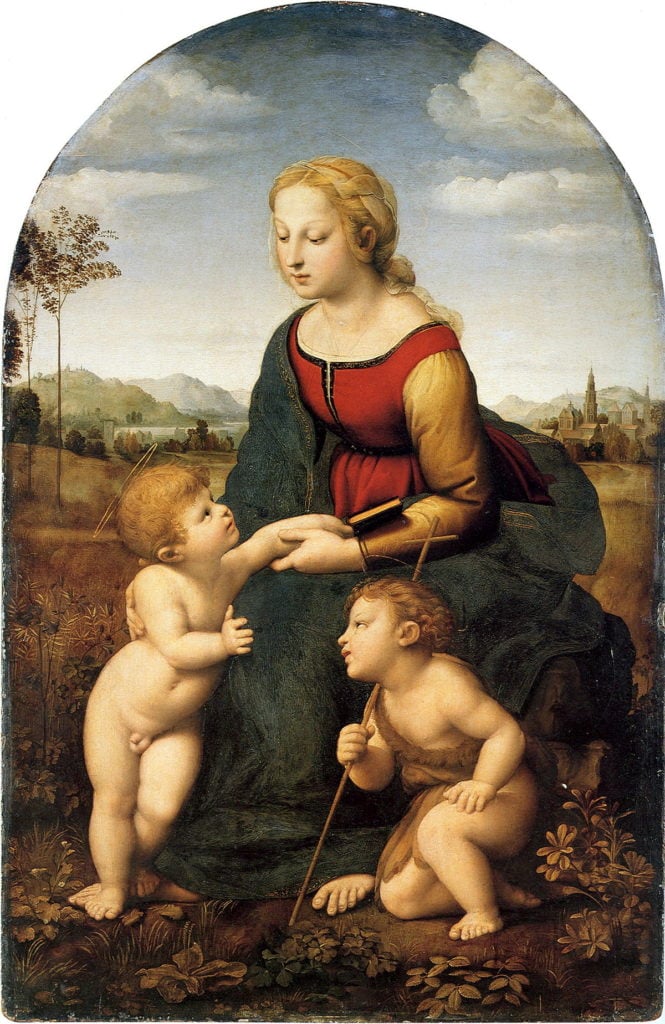"Raphael Sanzio"
 |
| "The School of Athens" (1509-1511) Apostolic Palace |
 |
| Raphael Sanzio (1483-1520) |
Raphael Sanzio was an an Italian artist during the High Renaissance. Raphael lived in Urbino, Italy. He was taught by his father a painter, who died when Raphael was very young. Life had taken a turn for him after his father's death. Raphael went to Perugia as an apprentice to the painter Perugino. The young artist was quickly noticed because of his talents. "No Renaissance artist so successfully- and repeatedly-invented and reinvented himself like as did Raphael." (Goffen 123) He moved to Florence and was famous for his Madonnas and large composition in the Vatican, "The School of Athens."
 |
| "La Belle Jardiniere" Madonna, Child, and Saint John the Baptist (1507) |
As for the School of Athens, the details are "under one roof, all the greatest scientists, mathematicians, and philosophers, and thinkers of ancient Greece, people who lived at different time periods." (High, 5:57-1:09) The painting brought all individuals together in that painting.
"Approximately one hundred paintings survived from his two decades of his professional activity, not to mention tapestry, cartoons, drawings, and architectural designs." (Goffen 123) Only eighteen of those paintings were signed. Of the eighteen only eight has the date and his name. First his signature was on stone or wood. Later, Raphael changed to labeling garments in his paintings.
Raphael's first signature most certainly was on the Crucifixion painting. During this time, Michelangelo and Raphael seem to have a competition between them. This started when Michelangelo lost to Raphael because the Sistine Chapel was to be painted by the winner Raphael. Their signatures also played a part in the rivalry too. Artist signatures were like designer labels. Over the time they went back and forth changing their signature, which represented their designer labels. "The placement of each signature-the particular where within each composition-is typically distinctive and significant." (Goffen 124) Either way, I personally like both of their work.
I chose this artist and the article because it explained how labels can mean many things even in art. "When names appear on garments, they likewise traditionally refer to the person who wears them, not to the maker." (Goffen 128) "But Medieval or Renaissance viewers reading a name on a garment or attribute, could assume that the inscription referred to the person represented." (Goffen 128) Understanding why an artist expresses oneself not only through art but by their signature; it shows there is more to their painting than we may see. How would you add a designer label signature to express you?
Raphael Sanzio 6 Interesting Facts (Video 5:03)
Artlistr. "Ralphael Sanzio 6 Interesting Facts." YouTube, Jan. 4, 2019, https://www.youtube.com/watch?v=bAkQtkEmLBc. Accessed 15 Mar. 2022.
Artnet. "The 10 Best Artworks by Raphael, Seraphic Genius of the Renaissance-Ranked." https://news.artnet.com/art-world/10-greatest-artworks-raphael-seraphic-genius-renaissance-ranked-1047047. Accessed 15 Mar 2022.
Cunningham."The High Renaissance in Italy." Cunningham and Reich's Culture and Values, Chapter 13., pp. 297-300.
Comments
Post a Comment